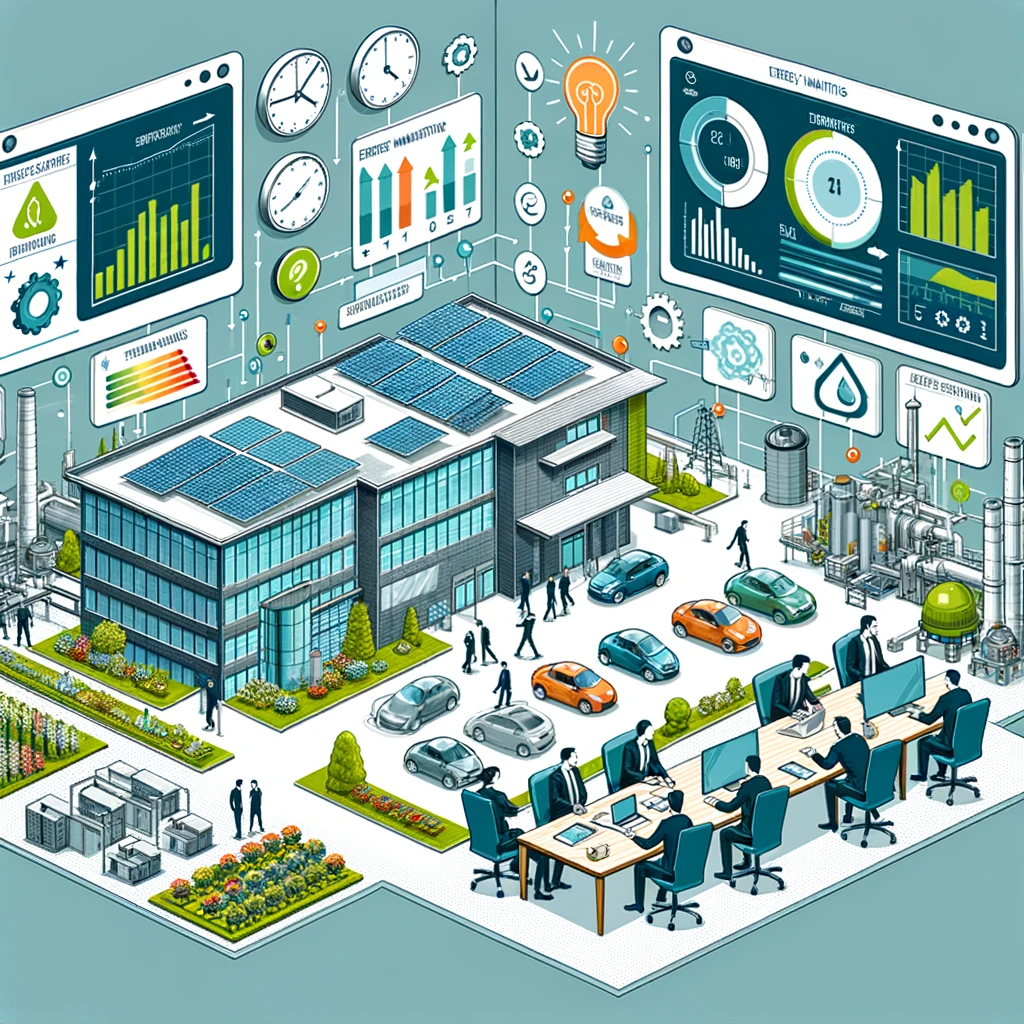Energy management encompasses a series of actions undertaken by organizations to monitor, plan, and optimize energy use, aiming to reduce consumption within their facilities and infrastructure. This process demands a proactive and systematic approach, forming an integral part of facilities management. The primary goals of energy management are to achieve cost savings, minimize carbon emissions, and ensure the efficient operation of facilities and essential assets.
Introduction to Energy-Efficient Facility Management
Definition and Importance
Energy-efficient facility management is a strategic approach to managing building and facility operations in a way that minimizes energy consumption and environmental impact. It encompasses practices such as utilizing energy-saving technologies, implementing building automation for optimized control, and conducting preventive maintenance to ensure efficient operation of systems. The importance of energy-efficient facility management lies in its ability to significantly reduce the carbon footprint of buildings, contribute to ecological conservation, and enable cost-cutting strategies without compromising the functionality or comfort of the facility. In today’s world, where sustainability is a critical concern, adopting energy-efficient practices in facility management is not only an environmental imperative but also a practical necessity for real estate sustainability and long-term cost savings [1].
Evolution of Facility Management towards Sustainability
The field of facility management has evolved significantly over the years, with a growing emphasis on sustainable practices and energy conservation. Initially focused primarily on maintaining building operations and managing costs, facility management has now integrated sustainability as a core aspect. This shift towards sustainability is driven by increased awareness of environmental issues, regulatory pressures, and the rising cost of energy. Modern facility management now routinely incorporates energy-efficient technologies, such as building automation systems and Energy Star-certified equipment, as well as practices aimed at reducing the overall environmental impact of facilities. This evolution reflects a broader trend in the real estate sector towards sustainability and demonstrates the pivotal role of facility management in achieving the United Nations’ Sustainable Development Goals (SDGs) [2].
Key Trends in Energy-Efficient Facility Management
Integration of Sustainable Practices
In the realm of facility management, integrating sustainable practices is becoming increasingly pivotal. This integration focuses on reducing energy consumption, thereby diminishing carbon emissions and promoting ecological conservation. Facility managers are adopting a range of sustainable practices, such as implementing energy-efficient systems and ensuring the buildings they manage comply with energy conservation guidelines. This not only contributes to carbon footprint reduction but also aligns with broader goals of real estate sustainability. Practices like utilizing renewable energy sources, enhancing waste management, and prioritizing sustainable materials in construction and maintenance are gaining momentum. Such measures are not just environmentally responsible but also lead to significant cost savings in the long term, making sustainable practices an intelligent choice for forward-thinking facility management [1].
Technological Innovations in Energy Management
Technological innovation plays a crucial role in advancing energy management within facility management. The use of building automation systems, for instance, allows for more precise control over heating, ventilation, air conditioning, and lighting systems, leading to optimized energy use. The integration of smart sensors and IoT devices provides real-time data that helps in making informed decisions about energy usage. Additionally, advanced software solutions are enabling better tracking and analysis of energy consumption patterns, leading to more effective strategies for energy conservation. These technological advancements not only enhance the efficiency of energy management but also contribute to significant cost-cutting strategies, making them an essential component of modern facility management [2].
The Role of Facility Managers in Energy Efficiency
Facility managers play a critical role in ensuring energy efficiency in buildings and facilities. Their responsibilities have evolved to include not just maintenance and operations but also strategizing for energy conservation and sustainability. They are at the forefront of implementing energy-efficient practices, such as conducting preventive maintenance to ensure optimal performance of equipment and obtaining Energy Star certifications for buildings. Facility managers are also instrumental in aligning energy management strategies with a company’s overall Environmental, Social, and Governance (ESG) initiatives. By actively engaging in practices that reduce energy consumption and carbon emissions, facility managers contribute significantly to ecological conservation and the overall sustainability of the real estate sector [3].
Strategies for Energy Efficiency in Facilities

Building Automation Systems
Building Automation Systems (BAS) are revolutionizing energy efficiency in facility management. These systems, integrating various building services like HVAC, lighting, and security, allow for automated and optimized control, leading to significant energy savings. By using sensors and real-time data analytics, BAS can adjust the energy consumption according to occupancy and usage patterns. This not only reduces the energy load but also ensures a comfortable environment for the occupants. Studies show that implementing BAS can result in considerable cost savings, as efficient energy use lowers utility bills and operating costs. Furthermore, the adoption of BAS aligns with sustainable practices and contributes to carbon footprint reduction, making it an essential strategy for modern, eco-conscious facilities [1].
Preventive Maintenance for Energy Conservation
Preventive maintenance is a critical strategy for energy conservation in facility management. Regular maintenance ensures that all building systems and equipment are functioning efficiently and as intended. By identifying and addressing potential issues before they become major problems, preventive maintenance helps in avoiding unnecessary energy consumption and prolonging the life of equipment. Facilities that implement a comprehensive preventive maintenance program can see a reduction in energy usage and costs, contributing to overall sustainability goals. This approach not only helps in conserving energy but also in maintaining optimal operational performance, thereby supporting the broader objectives of ecological conservation and cost-cutting [4].
Implementing Energy Star and Other Certification Standards
Adopting Energy Star and other energy certification standards is a strategic move for facilities aiming for energy efficiency. Energy Star, a widely recognized symbol for energy efficiency, provides a framework for facilities to reduce energy consumption and greenhouse gas emissions. By complying with these standards, facilities can achieve significant energy savings and operational cost reductions. Additionally, these certifications serve as a benchmark for sustainable practices, enhancing a facility’s reputation and commitment to environmental stewardship. Implementing these standards often involves upgrading to energy-efficient equipment, optimizing energy use, and adopting sustainable operational practices, all of which contribute to real estate sustainability and ecological conservation [3].
Challenges and Solutions in Energy-Efficient Facility Management
Overcoming Common Obstacles
In the journey towards energy-efficient facility management, several challenges frequently arise. Key among these is the lack of awareness and understanding of the benefits and methodologies of energy conservation. Economic factors also play a significant role, as initial investments in green technologies or building automation systems can be substantial, deterring some stakeholders. Additionally, overcoming the inertia of existing practices and integrating new technologies into older buildings can be complex. To overcome these obstacles, facility managers need to focus on educating stakeholders about the long-term cost savings and environmental benefits of energy efficiency. Implementing pilot projects to demonstrate the effectiveness of new technologies can be a persuasive approach. Furthermore, exploring financial incentives, grants, and rebates offered for energy-efficient upgrades can alleviate economic barriers [4, 6].
Case Studies of Successful Implementations
Several case studies highlight the success of implementing energy-efficient practices in facility management. For instance, in the UAE’s built environment, a case study approach revealed effective incorporation of decarbonization strategies, showcasing a significant reduction in energy consumption and carbon emissions. Another example is seen in healthcare facilities where the implementation of building automation systems led to notable energy conservation. These systems regulated energy use based on real-time occupancy and usage data, resulting in substantial cost savings and enhanced environmental sustainability. These case studies demonstrate the viability and benefits of energy-efficient practices in diverse settings. They serve as a blueprint for other facilities aiming to reduce their carbon footprint and embrace sustainable practices, proving that with the right strategies, the challenges of energy efficiency can be effectively tackled [2, 1].
Frequently Asked Questions
What is energy management in facility management?
Energy management within facility management involves the systematic monitoring, control, and optimization of energy use in buildings and facilities. It is a critical component of facility management, focusing on reducing energy consumption and improving efficiency. This practice encompasses various aspects like tracking energy usage, implementing energy-saving technologies, and adopting sustainable practices. Energy management in facilities aims to reduce operational costs, minimize environmental impact, and ensure the sustainable operation of building systems like HVAC, lighting, and water heating.
What is energy efficiency management?
Energy efficiency management refers to the process of optimizing energy use to reduce consumption while maintaining the same level of service or output. It involves identifying and implementing measures that can lower energy usage without compromising functionality. This includes upgrading to energy-efficient equipment, improving building insulation, and optimizing operational practices. Energy efficiency management not only leads to cost savings but also contributes to environmental conservation by reducing the carbon footprint associated with energy use.
What are 5 strategies for energy management?
Five key strategies for energy management include:
- Implementing building automation systems for optimized control of energy use.
- Conducting regular preventive maintenance to ensure efficient operation of equipment.
- Upgrading to energy-efficient appliances and systems, like LED lighting and high-efficiency HVAC units.
- Adopting Energy Star certification and other energy performance standards.
Implementing cost-cutting strategies such as energy audits and retrofitting older buildings for improved efficiency.
What is energy efficient technique?
An energy-efficient technique is a method or practice that reduces energy consumption while maintaining or improving the service provided. Examples include using LED lighting, which consumes less electricity than traditional bulbs, or installing programmable thermostats that optimize heating and cooling schedules to reduce energy use when a building is unoccupied.
What are the 3 parts of energy management?
The three main components of energy management are:
Monitoring: Tracking and analyzing energy consumption data to understand usage patterns.
Control: Implementing policies and technologies to regulate and optimize energy use.
Optimization: Continuously seeking ways to improve energy efficiency and reduce consumption, often through technological upgrades and operational changes.
What is the main goal of energy management system?
The primary goal of an energy management system is to achieve efficient and effective use of energy, leading to cost savings, reduced environmental impact, and enhanced operational efficiency. It aims to balance energy consumption with the needs of a facility, ensuring optimal performance while minimizing waste and reducing the carbon footprint.
What are 2 examples of energy efficiency?
Two examples of energy efficiency are:
Using appliances with high Energy Star ratings, which consume less energy compared to standard models.
Implementing building insulation improvements, which reduce the need for heating and cooling, thereby saving energy.
Which energy efficiency is best?
The “best” energy efficiency approach depends on specific circumstances and needs. Generally, strategies that offer significant energy savings, long-term cost benefits, and minimal environmental impact are considered most effective. These might include comprehensive building retrofits for older structures or the adoption of cutting-edge, energy-efficient technologies in new constructions.
What are the two types of energy efficiency?
The two types of energy efficiency are:
Passive energy efficiency, which involves design elements and materials that naturally reduce energy use, like better insulation or strategic window placement for natural lighting.
Active energy efficiency, which relies on technology and systems, such as energy-efficient appliances and automated energy management systems, to reduce energy consumption.

